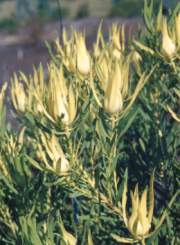Leucadendron salignum
Leucadendron salignum Berg.
Family: Proteaceae
Common names: common sunshine conebush (Eng.); geelbos (Afr.)
Introduction
Leucadendron salignum is the most widespread species of the family Proteaceae, occurring in a large part of South Africa.

Description
Description
Leucadendrons are dioecious, i.e. separate male and female plants. This is unusual in the protea family. Its long flowering season (May - Dec), coupled with colourful leaves and bracts surrounding the flowers, make this species an attractive garden plant.

Leucadendron salignum is a multi-stemmed shrub with a persistent rootstock, which enables it to resprout after fire. In its natural conditions it grows to a height of 0.75 to 2 m. The variability of growing conditions, from mild winter temperatures to snow and frost near mountain tops, as well as the variability of leaves and bracts, from greenish-yellow to vivid orange-red, have made this species an excellent candidate for breeding.
There are a range of plants in cultivation, which differ markedly from the usual parent species, most often in growth form, leaf- and bract colour and flowering time. They may be either selections, known as 'cultivars' or hybrids, i.e. 'crosses' between species. Many hybrids and cultivars have been produced in South Africa, New Zealand, Australia and other countries growing Proteaceae.
At Kirstenbosch only a few of the hybrids are grown, mostly L. x 'Safari Sunset', a hybrid of L. laureolum x L. salignum. This is one of the best known leucadendrons and an export flower crop in several countries. It is a tall, erect and vigorous shrub up to 2.5 m high. It produces large deep-red bracts on long stems from autumn through to late spring. These flare open to show cream centres when flowering.
L. x 'Silvan Red' is a hybrid of the same two species with a slightly lighter colour than ''Safari Sunset' and although usually hardy, is not as frost hardy as 'Safari Sunset'.
Distribution and habitat
Distribution description
It is common from Port Elizabeth in the east, to north of Ceres in the west. It occurs on a wide range of soil types, from sea level to an altitude of 2000 m and is quite variable in leaf size as well as leaf- and bract colour.
Uses
Use
This species adapts well to vigorous pruning, which makes it suitable for the production of cut foliage on a large scale.
These characteristics have made the species a natural choice for the wild flower industry.
Growing Leucadendron salignum
Grow
Cultivars and hybrids can only be propagated vegetatively. Cuttings have to be made from semi-hardwood, 6-10 cm long, of the current season's growth. The cuttings are dipped for about four seconds in a rooting hormone solution and placed in a growing house with bottom heat (25°C) and intermittent mist. The cuttings grow fast and are ready to be planted out after a year.
Credits
H G Jamieson
Kirstenbosch National Botanical Garden
November 2000
Plant Attributes:
Plant Type: Shrub
SA Distribution: Eastern Cape, Western Cape
Soil type: Sandy, Clay, Loam
Flowering season: Spring, Early Summer, Autumn, Winter
PH: Acid, Alkaline, Neutral
Flower colour: Red, Pink, Cream, Yellow, Orange
Aspect: Full Sun
Gardening skill: Average
Special Features:
Horticultural zones











Rate this article
Article well written and informative
Rate this plant
Is this an interesting plant?
Login to add your Comment
Back to topNot registered yet? Click here to register.